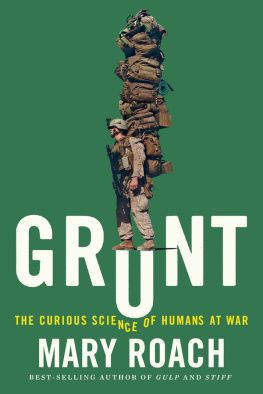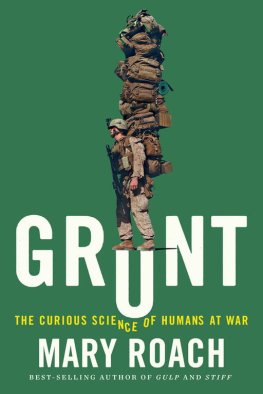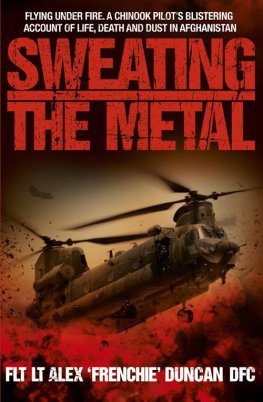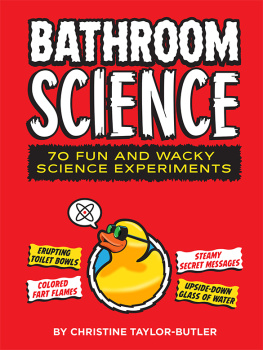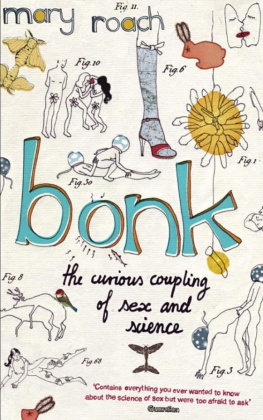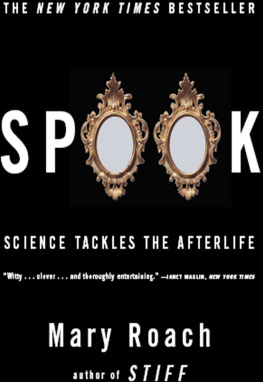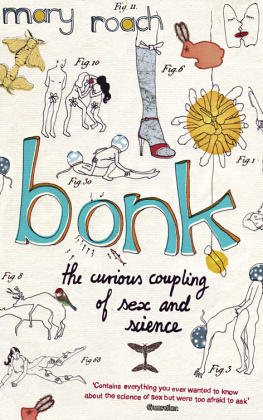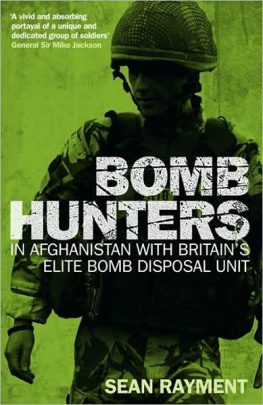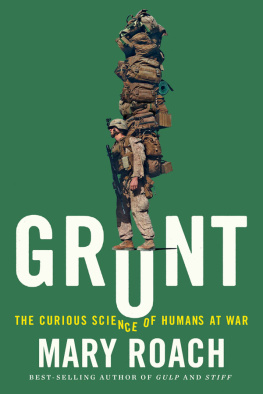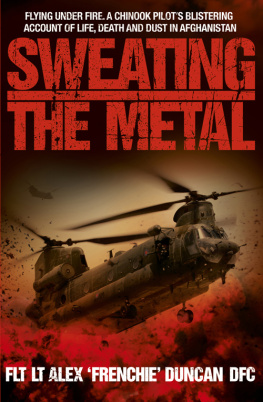

In memory of William S. Rachles
CONTENTS
What to wear to war
Automotive safety for people who drive on bombs
The conundrum of military noise
The cruelest shot of all
A salute to genital transplants
How do combat medics cope?
The war on heat
Diarrhea as a threat to national security
Flies on the battlefield, for better and worse
A brief history of stink bombs
How to make and test shark repellent
When things go wrong under the sea
A submarine tries to sleep
How the dead help the living stay that way
G
R
U
N
T
T HE CHICKEN GUN HAS a sixty-foot barrel, putting it solidly in the class of an artillery piece. While a four-pound chicken hurtling in excess of 400 miles per hour is a lethal projectile, the intent is not to kill. On the contrary, the chicken gun was designed to keep people alive. The carcasses are fired at jets, standing empty or occupied by simulated crew, to test their ability to withstand what the Air Force and the aviation industry, with signature clipped machismo, call birdstrike. The chickens are stunt doubles for geese, gulls, ducks, and the rest of the collective bird mass that three thousand or so times a year collide with Air Force jets, costing $50 million to $80 million in damage and, once every few years, the lives of the people on board.
As a bird to represent all birds, the chicken is an unusual choice, in that it doesnt fly. It does not strike a jet in the manner in which a mallard or goose strikes a jetwings outstretched, legs trailing long. It hits it like a flung grocery item. Domestic chickens are, furthermore, denser than birds that fly or float around in wetlands. At 0.92 grams per centimeter cubed, the average body density of Gallus gallus domesticus is a third again that of a herring gull or a Canada goose. Nonetheless, the chicken was the standard material approved by the US Department of Defense for testing jet canopy windows. Not only are chickens easier to obtain and standardize, but they serve as a sort of worst-case scenario.
Except when they dont. A small, compact bird like a starling can pierce a canopy windscreen like a bullet, and apparently does so often enough that someone saw fit to launch some jargon (the feathered bullet phenomenon). Would it be simpler to just keep birds away from runways? Youd think. But birds habituate. They quickly adjust to whatever predator sound or alarm call you broadcast or minor explosives you set off, just singing or calling more loudly and going about their lives as they always have.
Enter Malcolm Kelley and the Bird Aircraft Strike Hazard (BASH) team of the United States Air Force. Kelley and his team took a cross-disciplinary approach. Engineering, say hello to biology. Ornithology, meet statistics. Lets break this down, they said. Lets start with turkey vultures. Though implicated in only 1 percent of Air Force birdstrikes, the weighty raptors are, by one accounting, responsible for 40 percent of the damage. Kelley and the team attached transmitters to eight of them, tracked their flight habits and patterns, and combined this with other data to create a Bird Avoidance Model (BAM) that would enable flight schedulers to avoid high-risk times and air space. A simple improvement in Turkey Vulture understanding had, Kelley projected, the potential to save the Air Force $5 million per year, as well as the lives of unknown numbers of pilots (and turkey vultures).
Sifting through the data, Kelley noticed that when the frequency range of a jet engine sound overlapped with the frequency range of a species distress call, the likelihood of birdstrike appeared to be lower. Are we talking to the birds without realizing it? he wrote in a 1998 paper. Might there be a way to build on this? One problem, he knew, is that both birds and planes take off facing into the wind. Thus the former often do not see the latter bearing down on them from behind. It was Kelleys idea to add a meaningful signal to an aircrafts radar beam, something that would alert birds to the danger sooner, so theyd have time to react and get out of the way.
This is the sort of story that drew me to military sciencethe quiet, esoteric battles with less considered adversaries: exhaustion, shock, bacteria, panic, ducks. Surprising, occasionally game-changing things happen when flights of unorthodox thinking collide with large, abiding research budgets. People tend to think of military science as strategy and weaponsfighting, bombing, advancing. All that I leave to the memoir writers and historians. Im interested in the parts no one makes movies aboutnot the killing but the keeping alive. Even if what people are being kept alive for is fighting and taking other lives. Lets not let that get in the way. This book is a salute to the scientists and the surgeons, running along in the wake of combat, lab coats flapping. Building safer tanks, waging war on filth flies. Understanding turkey vultures.
T HE CHICKEN gun is most of what I have to say about guns. If youre wanting to read about the science of military armaments, this is not the book youre wanting to read. Likewise, this is no Zero Dark Thirty . I talk to Special Operations menNavy SEALs and Army Rangersbut not about battling insurgents. Here theyre battling extreme heat, cataclysmic noise, ill-timed gastrointestinal urgency.
For every general and Medal of Honor winner, there are a hundred military scientists whose names youll never hear. The work I write about represents a fraction of a percent of all that goes on. I have omitted whole disciplines of worthy endeavor. There is no chapter on countermeasures for post-traumatic stress disorder, for example, not because PTSD doesnt deserve coverage but because it has had so much, and so much of it is so very good. These books and articles aim the spotlight where it belongs. I am not, by trade or character, a spotlight operator. Im the goober with a flashlight, stumbling into corners and crannies, not looking for anything specific but knowing when Ive found it.
Courage doesnt always carry a gun or a flag or even a stretcher. Courage is Navy flight surgeon Angus Rupert, flying blindfolded and upside down to test a vibrating suit that lets pilots fly by feel should they become blinded or disoriented. Its Lieutenant Commander Charles Swede Momsen, saluting onlookers as hes lowered into the Potomac to test the first-ever submarine escape lung, or Captain Herschel Flowers of the Army Medical Research Laboratory, injecting himself with cobra venom to test the possibility of building immunity. Sometimes courage is nothing more than a willingness to think differently than those around you. In a culture of conformity, thats braver than it sounds. Courage is World War I medic William Baer, saving limbs and lives by letting maggots debride wounds. Its Dr. Herman Muller, volunteering to inject himself with cadaver blood to test the safety of transfusions from the dead to the wounded, a practice carried out on the battlefields of the Spanish-American War.
Heroism doesnt always happen in a burst of glory. Sometimes small triumphs and large hearts change the course of history. Sometimes a chicken can save a mans life.
___________
I quote the paper What Can Birds Hear? The author, Robert Beason, notes that acoustic signals work best when reinforced with activities that produce death or a painful experience... He meant for some members of the flock, whereupon the rest would presumably take note. As would animal rights activists, producing a painful experience for public affairs staff.
Next page
